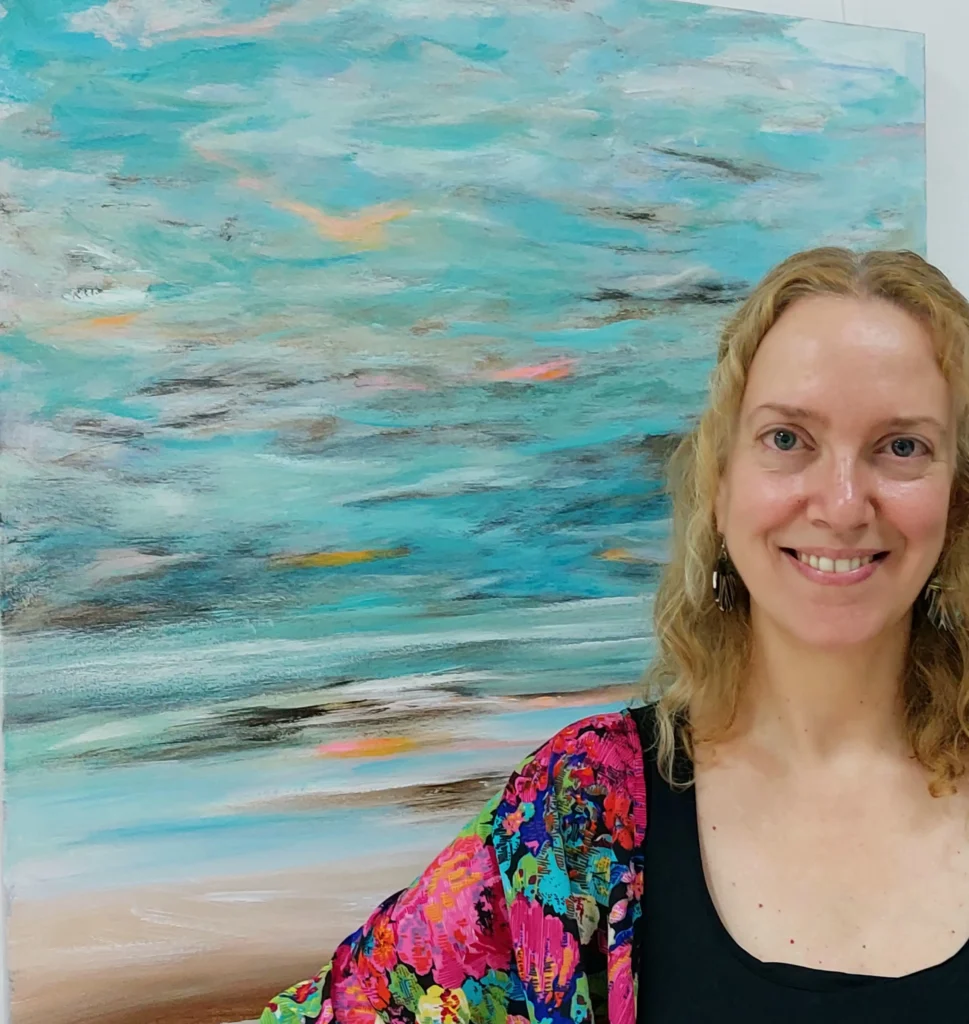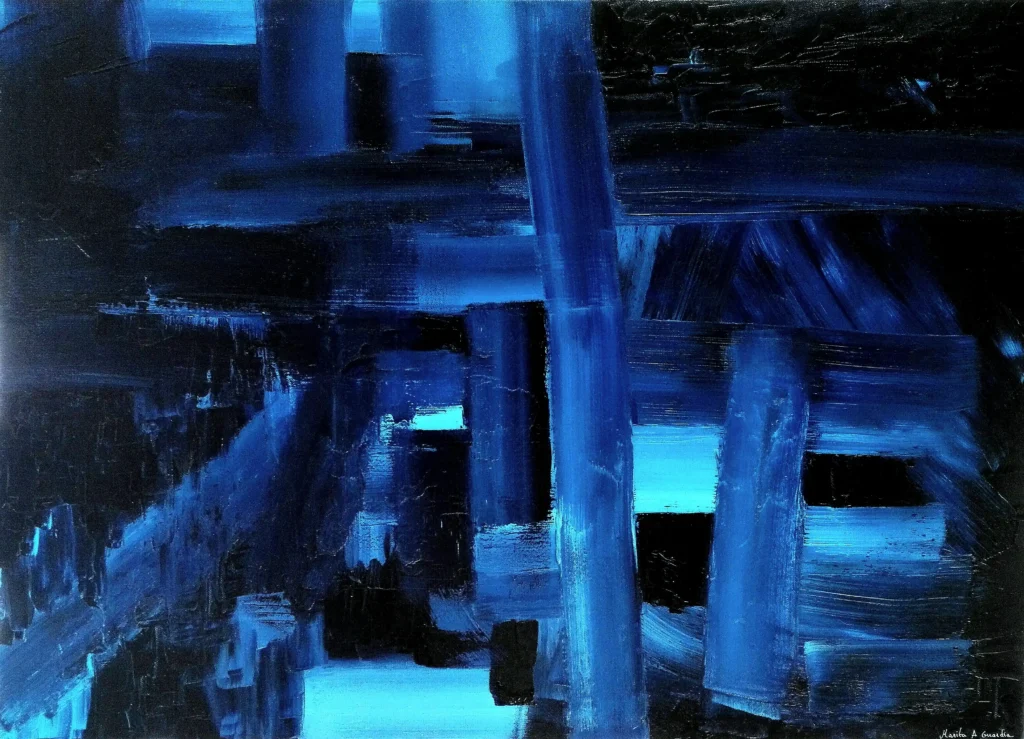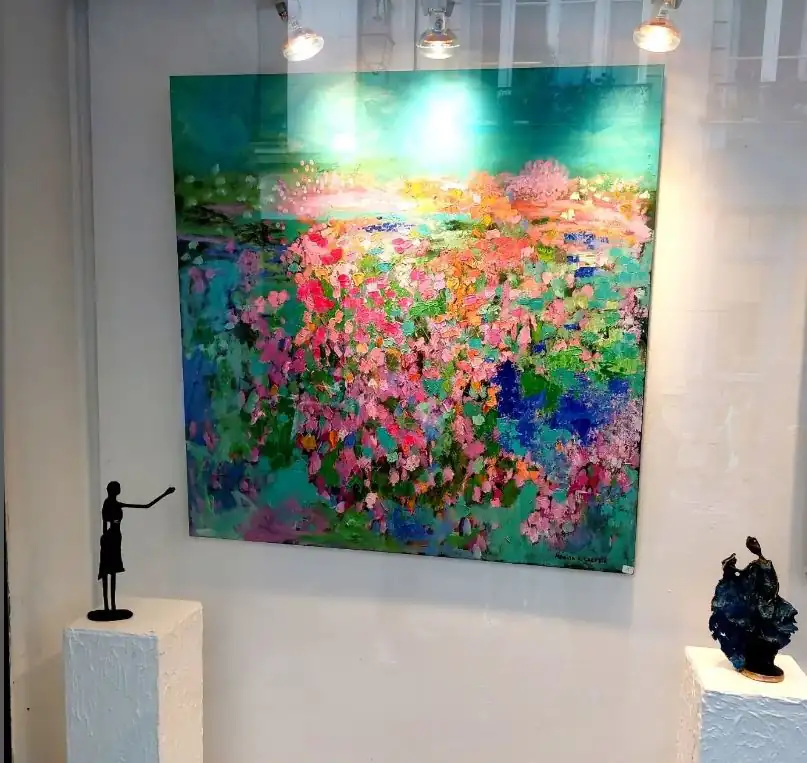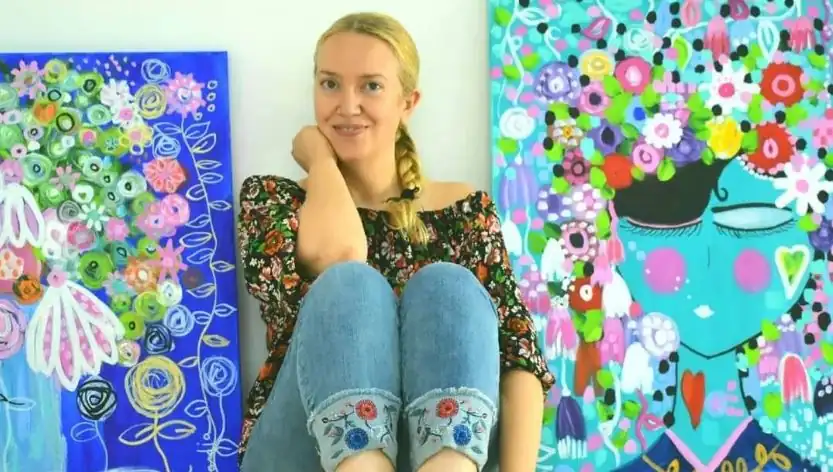An Interview with Artist Marita A. Guardia
To read the interview in Spanish, please download the PDF file.
Para leer la entrevista en español, por favor descarga el archivo PDF.
In this exclusive interview, self-taught artist Marita A. Guardia takes us on a journey through her creative process, revealing how she navigates the delicate balance between figurative and abstract art. Known for her bold use of color and deep emotional expression, Marita shares how her artistic instincts guide her every stroke, allowing her to create without boundaries. From her influences in Paris to the powerful connection between her work and her audience, she offers profound insights into the mysteries of art, emotion, and the freedom of being true to oneself.

- You describe yourself as a self-taught artist who values aesthetic beauty. How did you develop your artistic style, and what drives your passion for painting?
A nephew of my maternal grandfather was José Torres Guardia, a prominent national sculptor who has since passed away. I never got to meet him as he moved to Madrid at a young age for work. I don’t know if genetics have anything to do with these things, but I wanted to mention him as a tribute. It’s true that my maternal grandparents painted realism, and although my style isn’t realistic, I imagine those artistic emotions are within us from before we are born. This would answer the second part of the question. As for the development of my artistic style, it’s like the wind that blows – there’s no exact scientific method. I let it flow; this is purely the flow of the unknown. Magic? Why do I feel like painting a figure one moment and then hours later need to paint something abstract? Mysteries.
- You say art helps you stay in harmony with your essence. Can you explain in more detail how creating art aligns you with your life and inner self?
This answer is somewhat connected to the previous one. The air that flows. I now think that would be a good title for a new exhibition. If you allow yourself to be guided by an internal artistic need, you distance yourself from all the established norms, from any method. It’s magic – magic never has a definitive answer. It just centers you in that small, wonderful world.
- Color plays a fundamental role in your work. How do you approach the use of color to convey the energy and strength of a piece?
Same as before. I don’t think about the colors I’m going to use in a piece; it’s a thirst for one shade or another. It’s pure necessity. An internal cry that demands ice, storm, or cotton candy pink. I also like and identify with the Fauvist soul of the early 20th century. Besides the color madness, they had that anger against everything. A tree trunk didn’t have to be brown – it could be blue or pink! It’s fabulous. That’s the true cry of the artist. Their vision comes first because that’s how they felt it. The only way to CONVEY energy and strength in a work is by being TRUE TO YOUR ARTISTIC IMPULSES.
- You work in both figurative and abstract styles. How do you decide which style to use for a particular piece, and how does the process differ between the two?
The same thing happens when it comes to style and color. I don’t decide in a purely reflective way. I imagine that within the need to express a certain style, there’s a personal state – uncertainty, happiness, fear, sadness… Maybe that’s it, and the chosen style is something therapeutic, and even I don’t fully understand it.
- What is your creative process like? How do you go from an initial idea or feeling to the final artwork?
Yes, there are times when I let myself flow less, and the desire to paint something specific takes over. For example, I’m passionate about the cottages in British and French villages. This makes me want to paint them, and I certainly do. I search for photos online, or I go and photograph them myself, and then I pass them on to their lordship, Mr. Canvas.
- Can you describe a specific painting where the use of color was key to conveying the emotion or message you wanted to express?
Whenever I’m asked this, I think of “The Darkest NIGHT.” It was an autumn night, and they were burying a young man I had known since he was very small. I believe that painting represented that moment. The most incredible thing was that several people told me: “Your work has deeply moved me.” You saw more than just those blue lines. Art did its work.

- How do you select a color palette? Do you start with an emotion or idea that dictates the colors you will use?
Both. However, as I’ve mentioned, there’s no process here – it’s all a moment of madness in the sense of letting everything flow. Then, depending on what I want to convey, the tones are “polished.”
- You’ve taken art courses at the Carrousel du Louvre and exhibited in major cities like Paris, Vienna, and Monaco. How have these experiences influenced your artistic perspective and development?
For me, more than art fairs or courses, it’s Paris that has truly influenced me. I lived there for many years and visited the greatest museums. But Paris, along with genetics, is responsible for me painting. It’s too much Paris.
- What role do different cultures and cities play in inspiring your work? Have places like Paris, Vienna, and Barcelona influenced your choice of colors or themes?
This question connects with the previous one, and the answer is obviously that their influence has been vital. But as I said, Paris is the only one to blame. Including the tones, I’m sure of it.
- You have a master’s degree in “Management and Valorization of Contemporary Art.” How has this academic training influenced how you create and present your work?
This master’s degree was wonderful but only on a theoretical level. Everything else, you have to carry within. I learned theoretical matters with enthusiasm because I was interested and hungry for knowledge.


- Do you believe viewers should interpret your work based on their personal emotions, or do you aim to guide them toward a specific message?
No, absolutely not. I don’t have to guide them at all. They can ask me why, and if I have an answer, I’ll give it to them. That’s one thing. But if they want to see what it represents for them, that’s fabulous, and they should find it. I can’t and shouldn’t guide them in that wonderful moment. It’s like books. The magic of books is that beyond the theme, there’s always a message between the lines for each person. The same happens with paintings. Beyond the employed theme, each person will receive something very special and personal, and I won’t interfere with that wonderful moment.
- How do you balance the personal meaning you give to your work with the interpretations viewers may have?
I always receive their interpretations with surprise and good cheer because, as I mentioned, it’s so personal. If I painted realism, there wouldn’t be much room for interpretation, but with faces and abstract art, there’s so much emotion involved. Even with the seascapes I do. It’s not just sea and sand – there’s a world of turquoise and blues with incredible dialogues.
- What do you think is the most important quality a work of art should have to evoke an emotional response from the audience?
I don’t know how to answer that, but I don’t think there’s a definitive or strong answer. Why does something move us? There’s no way to explain it. Here, the soul of the spectators plays a role as well.
- Has there been any exhibition or interaction with the public that stands out to you for showing a deep connection between your work and the audience?
In Denia, but that’s because I’m present the entire time, which generates all kinds of feelings in me. I see their faces and hear what they tell me. It’s super interesting. Once, with an abstract piece, a woman came into the gallery twice more to tell me what it was stirring in her mind. That really impacted me. She needed to tell me!
- What’s the next step in your artistic journey? Is there any upcoming project or exhibition that particularly excites you?
Yes, Germany! I have several works there, purchased by Germans, but I’ve never exhibited there. Next month, I’ll be in Munich at the MUC Art Fair. I’ll be bringing color and figures – I want to make an impact because that’s exactly what this country has always done for me. I love Germany.
- You have extensive exhibition experience in different countries. How do you think your work is perceived in different cultural contexts?
I believe people, based on what I’ve seen in face-to-face exhibitions, feel empathy, and that’s good. I’ve reflected on this, and I think my way of viewing art is close to popular taste. I believe, in some way, they see themselves reflected in it. Or perhaps they sense that what my works reflect is something made with the soul.


- How do you deal with creative blocks or moments when inspiration seems lost? How do you regain your creative flow?
When there’s no inspiration, nothing can be done, and when there is, everything can be done. It’s incredible. We don’t have control over it, and you don’t know why, but that’s how it is. If you accept the natural flow of that temporary lack of inspiration, it’s because you understand the natural mechanism, and thus, I don’t despair. I focus on something else until inspiration starts screaming at me, and then I head back to the studio with more energy!
- Do you use music, environments, or other specific sources of inspiration when you work? What role does the environment play in your creative process?
I don’t usually use music, but I admit that on some occasions I have, and it was even more magical, so I’ll have to consider working alongside a disco.
- What’s your attitude toward criticism? How do you respond to it? Does it ever influence your approach or work?
Haha, criticism, well, it depends. A well-founded critique is wonderful and a gift, as long as it nourishes and enriches me. What I can’t handle well are absurd comments like: “It’s too dark, too light, too colorful, too bold, the hand is too small…” and other such ridiculous things, haha. Maybe they don’t realize that was exactly what I intended – for it to be too dark, too colorful, too bold, and for the hand to be deliberately small. I don’t do realism, so those judgments don’t make sense.

